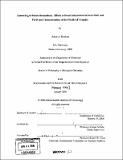Channeling in purine biosynthesis : efforts to detect interactions between PurF and PurD and characterization of the FGAR-AT complex
Author(s)
Hoskins, Aaron A. (Aaron Andrew)
DownloadFull printable version (32.04Mb)
Other Contributors
Massachusetts Institute of Technology. Dept. of Chemistry.
Advisor
Jo Anne Stubbe.
Terms of use
Metadata
Show full item recordAbstract
Purine biosynthesis has been used as a paradigm for the study of metabolism of unstable molecules. Both phosphoribosylamine (PRA) and N5-carboxyaminoimidazole ribonucleotide (N5-CAIR) have estimated half-lives in vivo of seconds. In order to avoid metabolite decomposition, one strategy cells could employ is channeling-the direct transfer of a metabolite between enzyme active sites without diffusion into the bulk media. While kinetic evidence for channeling of PRA has been reported between phosphoribosylpyrophosphate amidotransferase (PurF) and glycinamide ribonucleotide synthetase (PurD), no evidence for a PurF:PurD complex has been found. In an effort to detect this complex, stopped-flow fluorescence spectroscopy was used to detect changes in PurF fluorescence that may result from interaction with PurD. Critical to the success of these experiments was incorporation of tryptophan analogs (4-fluorotryptophan and 7-azatryptophan) into the proteins in order to increase signal specificity for PurF. No evidence for a PurF:PurD interaction was found under any of the conditions tested. The implication of this finding is discussed with regard to the PurF:PurD channeling model. Like all amidotransferase enzymes (ATs), channeling of NH3 between glutaminase and AT active sites has been implicated in the formylglycinamide ribonucleotide amidotransferase (FGAR-AT). (cont.) In B. subtilis, the FGAR-AT is composed of three proteins: PurS, PurQ, and small PurL. The first characterization of the B. subtilis FGAR-AT complex was carried out, and it was determined that a complex between the three proteins can only be isolated in the presence of Mg2+-ADP and glutamine. By analogy to the Salmonella FGAR-AT, ADP is believed to be acting as a structural cofactor, while formation of a PurQ-glutamine complex is essential for assembly of the FGAR-AT. Subsequent biophysical studies have indicated that the physiologically relevant form of the FGAR-AT complex contains 2 PurS, 1 PurQ, and 1 small PurL. Further studies on PurQ have identified residues important for catalysis and complex formation, while insight into the small PurL active site has been obtained by studies on the T. maritima enzyme. The FGAR-AT complex provides a new system in purine biosynthesis to study metabolite transfer among weakly interacting proteins.
Description
Thesis (Ph. D.)--Massachusetts Institute of Technology, Dept. of Chemistry, 2006. Vita. Includes bibliographical references.
Date issued
2006Department
Massachusetts Institute of Technology. Department of ChemistryPublisher
Massachusetts Institute of Technology
Keywords
Chemistry.